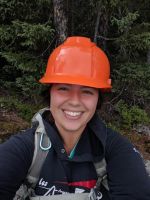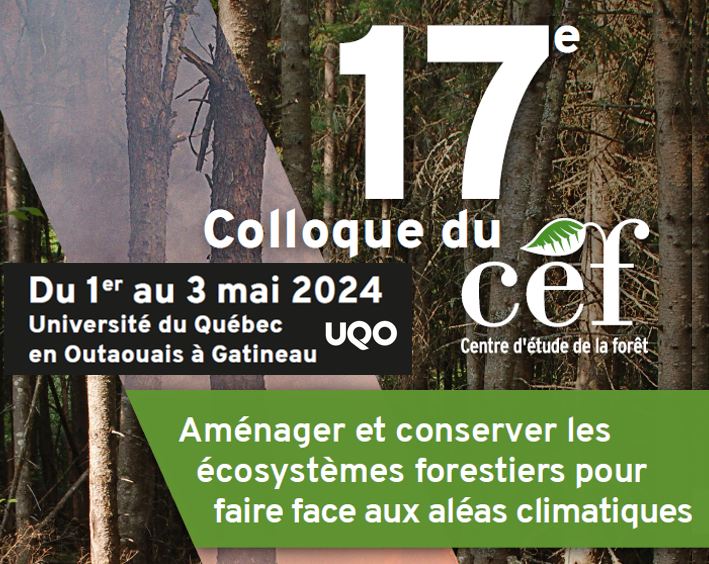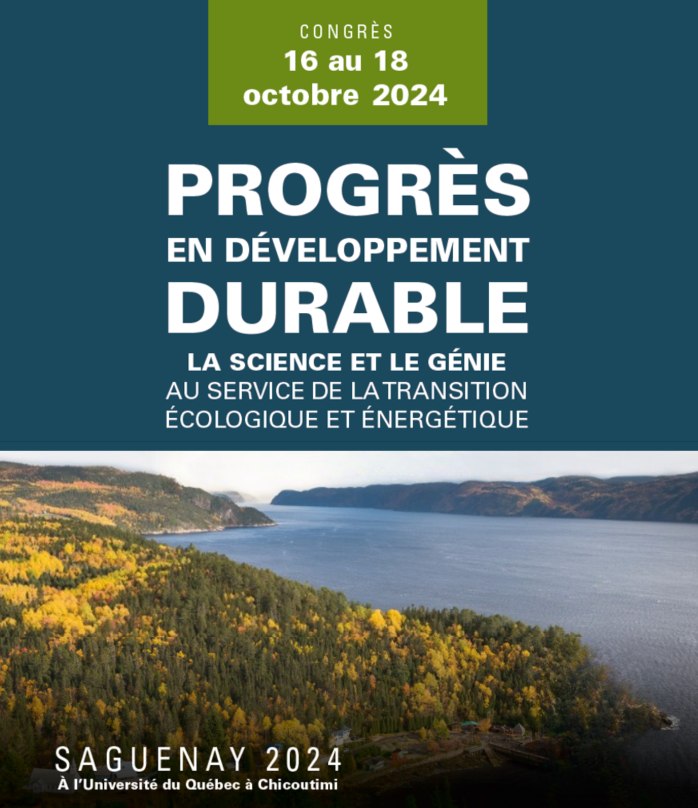
Robert L. Bradley
Membre régulier
Écologie des sols
Université de Sherbrooke
Faculté des Sciences
Département de biologie
2500, boul. de l'Université
Sherbrooke (Québec) Canada, J1K 2R1
(819) 821-8000 Poste 62080
FORMATION
- Postdoctorat en modélisation, 1996-1998 (University of British Columbia)
- Ph.D. en écologie forestière, 1996 (Université McGill) Directeur : James William Fyles
- B.Sc. en conservation des sols, 1989 (Université McGill)
THÈMES DE RECHERCHE
Écologie des sols
Les flux d’énergie et le cyclage d’éléments nutritifs sont deux aspects fondamentaux du fonctionnement des écosystèmes terrestres. Le sol représente une "zone chaude" d'activités biologiques où se couple les métabolismes autotrophes et hétérotrophes. Dans mon laboratoire, on s’intéresse principalement aux cycles du carbone et de l'azote, à la nutrition minérale et organique des végétaux, à l'activité et la diversité des communautés microbiennes du sol, à la rhizosphère, aux mycorhizes et à certains groupes fauniques du sol. Ces divers volets de recherche cadrent dans un plus large contexte qui est de décrire les effets des perturbations naturelles et anthropiques sur la succession des écosystèmes forestiers. Ces travaux visent donc à faire évoluer les concepts et les modèles théoriques de la succession écologique qui pourraient éventuellement nous aider à mieux gérer nos forêts.
Ce programme de recherche consiste en un travail d'équipe avec les étudiants gradués de l’université de Sherbrooke, misant sur la collaboration de partenaires québécois et canadiens des secteurs publics et privés.
Je suis aussi un membre du Centre de recherche en écologie terrestre de l'Université Sherbrooke ![]() et membre associé au Centre de recherche interinstitutionnel en amélioration végétale (SÈVE)
et membre associé au Centre de recherche interinstitutionnel en amélioration végétale (SÈVE) ![]()
Vous pouvez télécharger toutes mes références bibliographiques en format BibTeX, BibTeX-CSV ou EndNote
PUBLICATIONS
Livres
Aucun
Chapitres de livre
- Thevathasan, N.V., Gordon, A.M., Bradley, R.L., Cogliastro, A., Folkard, P., Grant, R., Kort, J., Liggins, L., Njenga, F., Olivier, A. et al. (2012) Agroforestry Research and Development in Canada: The Way Forward. In Agroforestry - The Future of Global Land Use. (Ramachandran Nair, P.K. and Garrity, D., Eds.) Springer, pages 247-284
Livres, numéros spéciaux et actes de colloques publiés à titre d'éditeur
Aucun
Articles révisés par un comité de lecture
- Scott, T., Bradley, R.L., Bourgault, P. (2024) Non-native earthworms increase the abundance and diet quality of a common woodland salamander in its northern range. Biological Invasions, 26(1):187 – 200
- Benoist, A., Houle, D., Bradley, R.L., Bellenger, J.-P. (2024) Deciphering factors controlling decay and nitrogen accumulation in coarse wood debris of five tree species using 15N labeled wood disks. Soil Biology and Biochemistry, 190
- Boilard, G., Bradley, R.L., Houle, D. (2023) A northward range shift of sugar maple (Acer saccharum) in Eastern Canada should reduce soil carbon storage, with no effect on carbon stability. Geoderma, 432
- Reicis, K., Bradley, R.L., Joanisse, G., Thiffault, N., Scott, D., Parsons, W.F.J. (2023) Mechanical scarification can reduce competitive traits of boreal ericaceous shrubs and improve nutritional site quality. Forestry, 96(2):293-303
- Renaudin, M., Blasi, C., Bradley, R.L., Bellenger, J.-P. (2022) New insights into the drivers of moss-associated nitrogen fixation and cyanobacterial biomass in the eastern Canadian boreal forest. Journal of Ecology, 110(6):1403 – 1418
- Chagnon, P.-L., Bradley, R.L., Lafond, J., Pare, M.C., Penaud, V. (2022) Trait-based and phylogenetic filtering of arbuscular mycorrhizal fungal communities under long-term agricultural practices. Plant and Soil, 471(1-2):273-287
- Darnajoux, R., Bradley, R.L., Bellenger, J.-P. (2022) In Vivo Temperature Dependency of Molybdenum and Vanadium Nitrogenase Activity in the Heterocystous Cyanobacteria Anabaena variabilis. Environmental Science and Technology, 56(4):2760-2769
- Benoist, A., Houle, D., Bradley, R.L., Bellenger, J.-P. (2022) Evaluation of biological nitrogen fixation in coarse woody debris from Eastern Canadian boreal forests. Soil Biology and Biochemistry, 165
- Ejack, L., Kernecker, M.L., Prieto, R., Chen, C., Gul, S., Bradley, R.L., Whalen, J.K. (2021) Earthworms did not increase long-term nitrous oxide fluxes in perennial forage and riparian buffer ecosystems. Pedobiologia, 85-86
- Phillips, H.R.P., Bach, E.M., Bartz, M.L.C., Bennett, J.M., Beugnon, R., Briones, M.J.I., Brown, G.G., Ferlian, O., Gongalsky, K.B., Guerra, C.A. et al. (2021) Global data on earthworm abundance, biomass, diversity and corresponding environmental properties. Scientific Data, 8(1)
- Cameron, A., Boilard, G., Dubois, R., Bradley, R.L., Benetkova, P., Jozefowska, A., Thevathasan, N., Whalen, J., Simek, M. (2021) Distribution of earthworm communities in agroecosystems with forested riparian buffer strips: A multiscale study. Applied Soil Ecology, 167
- Marty, C., Piquette, J., Dussault-Chouinard, E., Morin, H., Thiffault, N., Houle, D., Bradley, R.L., Ouimet, R., Simpson, M.J., Pare, M.C. (2020) Canopy Nitrogen Addition and Soil Warming Affect Conifer Seedlings’ Phenology but Have Limited Impact on Growth and Soil N Mineralization in Boreal Forests of Eastern Canada. Frontiers in Forests and Global Change, 3:121
- Meehan, M.L., Barreto, C., Turnbull, M.S., Bradley, R.L., Bellenger, J.-P., Darnajoux, R., Lindo, Z. (2020) Response of soil fauna to simulated global change factors depends on ambient climate conditions. Pedobiologia, 83
- Wotherspoon, A., Thiffault, N., Bradley, R.L. (2020) Resource availability and physiological response of black spruce to scarification in two climatic regions of Québec (Canada). Silva Fennica, 54(4):10375
- Wotherspoon, A., Bradley, R.L., Houle, D., Tremblay, S., Barrette, M., Reicis, K. (2020) Mechanisms by which pre-commercial thinning increases black spruce growth in different climates and soil types. Forests, 11(5)
- Chagnon, P.-L., Bradley, R.L., Klironomos, J.N. (2020) Mycorrhizal network assembly in a community context: The presence of neighbours matters. Journal of Ecology, 108(1):366-377
- Reicis, K., Bradley, R.L., Joanisse, G., Houle, D., Tremblay, S., Barrette, M., Wotherspoon, A. (2020) Pre-commercial thinning enhances competitive traits of boreal ericaceous shrubs and reduces soil fertility. Forest Ecology and Management, 458
- Phillips, H.R.P., Guerra, C.A., Bartz, M.L.C., Briones, M.J.I., Brown, G., Crowther, T.W., Ferlian, O., Gongalsky, K.B., Van Den Hoogen, J., Krebs, J. et al. (2019) Global distribution of earthworm diversity. Science, 366(6464):480-485
- Boilard, G., Bradley, R.L., Paterson, E., Sim, A., Brown, L.K., George, T.S., Bainard, L., Carubba, A. (2019) Interaction between root hairs and soil phosphorus on rhizosphere priming of soil organic matter. Soil Biology and Biochemistry, 135:264-266
- Marty, C., Levesque, J.-A., Bradley, R.L., Lafond, J., Pare, M.C. (2019) Contrasting impacts of two weed species on lowbush blueberry fertilizer nitrogen uptake in a commercial field. PLOS ONE, 14(4)
- Marty, C., Piquette, J., Morin, H., Bussieres, D., Thiffault, N., Houle, D., Bradley, R.L., Simpson, M.J., Ouimet, R., Pare, M.C. (2019) Nine years of in situ soil warming and topography impact the temperature sensitivity and basal respiration rate of the forest floor in a Canadian boreal forest. PLOS ONE, 14(12):e0226909
- Scott, D.L., Bradley, R.L., Bellenger, J.-P., Houle, D., Gundale, M.J., Rousk, K., DeLuca, T.H. (2018) Anthropogenic deposition of heavy metals and phosphorus may reduce biological N2 fixation in boreal forest mosses. Science of the Total Environment, 630:203-210
- Girona, J., Bradley, R.L., Levesque, J.-A., Pare, M., Bellemare, M. (2018) A Call For Improving Winter Windbreak Design for Lowbush Blueberry Production in the Saguenay–Lac-Saint-Jean Region of Québec, Canada. International Journal of Fruit Science
- Levesque, J.-A., Bradley, R.L., Bellemare, M., Lafond, J., Pare, M.C. (2018) Predicting weed and lowbush blueberry biomass using the point intercept method. Canadian Journal of Plant Science, 98(4):967-970
- Joanisse, G.D., Bradley, R.L., Preston, C.M. (2018) The spread of Kalmia angustifolia on black spruce forest cutovers contributes to the spatial heterogeneity of soil resources. PLOS ONE, 13(6)
- Darnajoux, R., Bradley, R.L., Houle, D., Bellenger, J.-P. (2018) Predictable spatial patterns of biological nitrogen fixation in forest floor mosses: Color matters! Soil Biology and Biochemistry, 122:160-162
- Fugere, M., Bradley, R.L., Vellend, M. (2017) Exotic earthworms dispersion through protected forest areas and their potential impacts on nitrous oxide production. Biological Invasions, 19(3):773-783
- Rousk, K., Degboe, J., Michelsen, A., Bradley, R.L., Bellenger, J.-P. (2017) Molybdenum and phosphorus limitation of moss-associated nitrogen fixation in boreal ecosystems. New Phytologist, 214(1):97-107
- Cuellar, M.A., Allaire, S.E., Lange, S.F., Bradley, R.L., Parsons, W.F.J., Rivest, D., Cogliastro, A. (2017) Greenhouse gas dynamics in a tree-based intercropping system compared with an organic conventional system. Canadian Journal of Soil Science, 97(3):382-393
- Jean, P.-O., Bradley, R.L., Berthiaume, R., Tremblay, J.-P. (2016) Evaluating old and novel proxies for in vitro digestion assays in wild ruminants. Wildlife Society Bulletin, 40(2):359-367
- Grant, R.F., Kinch, T.A., Bradley, R.L., Whalen, J.K., Cogliastro, A., Lange, S.F., Allaire, S.E., Parsons, W.F.J. (2016) Carbon sequestration vs. Agricultural yields in tree-based intercropping systems as affected by tree management. Canadian Journal of Soil Science, 97(3):416-432
- Gauthier, M., Bradley, R.L., Lange, S., Allaire, S., Parsons, W., Cuellar, M.A. (2016) Tree-based intercropping may reduce, while fertilizer nitrate may increase, soil methane emissions. Canadian Journal of Soil Science, 97(3):410-415
- Ndanga, E.M., Lopera, C.B., Bradley, R.L., Cabral, A.R. (2016) Effects of preconditioning the rhizosphere of different plant species on biotic methane oxidation kinetics. Waste Management, 55:313-320
- Winans, K.S., Whalen, J.K., Rivest, D., Cogliastro, A., Bradley, R.L. (2016) Carbon sequestration and carbon markets for tree-based intercropping systems in southern Quebec, Canada. Atmosphere, 7(2)
- Drouin, M., Bradley, R.L., Lapointe, L. (2016) Linkage between exotic earthworms, understory vegetation and soil properties in sugar maple forests. Forest Ecology and Management, 364:113-121
- Kernecker, M., Whalen, J.K., Bradley, R.L. (2015) Agricultural management and flooding shape habitats for non-native earthworms in southern Quebec, Canada. Applied Soil Ecology, 96:240-250
- Ndanga, T.M., Bradley, R.L., Cabral, A.R. (2015) Does vegetation affect the methane oxidation efficiency of passive biosystems? Waste Management, 38(1):240-249
- Jean, P.-O., Bradley, R.L., Tremblay, J.-P., Cote, S.D. (2015) Combining near infrared spectra of feces and geostatistics to generate forage nutritional quality maps across landscapes. Ecological Applications, 25(6):1630-1639
- Chagnon, P.-L., Bradley, R.L. (2015) The relative importance of host vigor and hormonal response to pathogens in controlling the development of arbuscular mycorrhizal fungi. Soil Biology and Biochemistry, 83:40-42
- Jean, P.-O., Bradley, R.L., Tremblay, J.-P. (2015) Testing for Bottom-up Effects in an Overbrowsed Boreal Landscape. Wildlife Biology, 21(6):318-322
- Chagnon, P.-L., Bradley, R.L., Klironomos, J.N. (2015) Trait-based partner selection drives mycorrhizal network assembly. Oikos, 124(12):1609-1616
- Gauthier, M., Bradley, R.L., Simek, M. (2015) More evidence that anaerobic oxidation of methane is prevalent in soils: Is it time to upgrade our biogeochemical models? Soil Biology and Biochemistry, 80:167-174
- Kernecker, M., Whalen, J.K., Bradley, R.L. (2014) Litter Controls Earthworm-Mediated Carbon and Nitrogen Transformations in Soil from Temperate Riparian Buffers. Applied and Environmental Soil Science, 2014
- Chagnon, P.-L., Bradley, R.L., Klironomos, J.N. (2014) Plant-fungal symbioses as ecological networks: The need to characterize more than just interaction patterns. Fungal Ecology, 12(C):10-13
- Kernecker, M., Whalen, J.K., Bradley, R.L. (2014) Endogeic earthworms lower net methane production in saturated riparian soils. Biology and Fertility of Soils, 51(2):271-275
- Jean, P.-O., Bradley, R.L., Giroux, M.-A., Tremblay, J.-P., Cote, S.D. (2014) Near infrared spectroscopy and fecal chemistry as predictors of the diet composition of white-tailed deer. Rangeland Ecology and Management, 67(2):154-159
- Drouin, M., Bradley, R.L., Lapointe, L., Whalen, J. (2014) Non-native anecic earthworms (Lumbricus terrestris L.) reduce seed germination and seedling survival of temperate and boreal trees species. Applied Soil Ecology, 75:145-149
- Vessey, J.K., Fei, H., Burton, D.L., Bradley, R.L., Smith, D.L. (2014) The bilateral influence of plant and rhizosphere characteristics in brassicas varying in seed oil productivity. Canadian Journal of Plant Science, 94(6):1113-1116
- Chagnon, P.-L., Bradley, R.L. (2013) Evidence that soil nutrient stoichiometry controls the competitive abilities of arbuscular mycorrhizal vs. root-borne non-mycorrhizal fungi. Fungal Ecology, 6(6):557-560
- Kyselkova, M., Jirout, J., Chronakova, A., Vrchotova, N., Bradley, R.L., Schmitt, H., Elhottova, D. (2013) Cow excrements enhance the occurrence of tetracycline resistance genes in soil regardless of their oxytetracycline content. Chemosphere, 93(10):2413-2418
- Chagnon, P.-L., Bradley, R.L., Maherali, H., Klironomos, J.N. (2013) A trait-based framework to understand life history of mycorrhizal fungi. Trends in Plant Science, 18(9):484-491
- Bergeron, S.P., Bradley, R.L., Munson, A.D., Parsons, W.F.J. (2013) Physico-chemical and functional characteristics of soil charcoal produced at five different temperatures. Soil Biology and Biochemistry, 58:140-146
- Thiffault, N., Fenton, N.J., Munson, A.D., Hebert, F., Fournier, R.A., Valeria, O., Bradley, R.L., Bergeron, Y., Grondin, P., Pare, D. et al. (2013) Managing Understory Vegetation for Maintaining Productivity in Black Spruce Forests: A Synthesis within a Multi-Scale Research Model. Forests, 4(3):613-631
- Fox, M.D., Tackaberry, L.E., Drouin, P., Bergeron, Y., Bradley, R.L., Massicotte, H.B., Chen, H.Y.H. (2013) Microbial community structure of soils under four productivity classes of aspen forests in Northern British Columbia. Ecoscience, 20(3):264-275
- LeBel, P., Bradley, R.L., Thiffault, N. (2013) he Relative Importance of Nitrogen vs. Moisture Stress May Drive Intraspecific Variations in the SLA-RGR Relationship: The Case of Picea mariana Seedlings. American Journal of Plant Sciences, 4(6):1278-1284
- Bradley, R.L., Chronakova, A., Elhottova, D., Simek, M. (2012) Interactions between land-use history and earthworms control gross rates of soil methane production in an overwintering pasture. Soil Biology and Biochemistry, 53:64-71
- Aulen, M., Shipley, B., Bradley, R.L. (2012) Prediction of in situ root decomposition rates in an interspecific context from chemical and morphological traits. Annals of Botany, 109(1):287-297
- Chagnon, P.-L., Bradley, R.L., Klironomos, J.N. (2012) Using ecological network theory to evaluate the causes and consequences of arbuscular mycorrhizal community structure. New Phytologist, 194(2):307-312
- Lorente, M., Parsons, W.F.J., Bradley, R.L., Munson, A.D. (2012) Soil and plant legacies associated with harvest trails in boreal black spruce forests. Forest Ecology and Management, 269:168-176
- Dufresne, M., Bradley, R.L., Tremblay, J.-P., Cote, S.D. (2011) Evidence that soil depth and clay content control the post-disturbance regeneration of balsam fir and paper birch under heavy browsing from deer. Ecoscience, 18(4):363-368
- Bergeron, M., Lacombe, S., Bradley, R.L., Whalen, J.K., Cogliastro, A., Jutras, M.-F., Arp, P. (2011) Reduced soil nutrient leaching following the establishment of tree-based intercropping systems in eastern Canada. Agroforestry Systems, 83(3):321-330
- Royer-Tardif, S., Bradley, R.L. (2011) Evidence that soil fertility controls the mixing of jack pine with trembling aspen. Forest Ecology and Management, 262(6):1054-1060
- Royer-Tardif, S., Bradley, R.L. (2011) Forest floor properties across sharp compositional boundaries separating trembling aspen and jack pine stands in the southern boreal forest. Plant and Soil, 345(1):353-364
- Bradley, R.L., Whalen, J.K., Chagnon, P.-L., Lanoix, M., Alves, M.C. (2011) Nitrous oxide production and potential denitrification in soils from riparian buffer strips: Influence of earthworms and plant litter. Applied Soil Ecology, 47(1):6-13
- Chagnon, P.-L., Bradley, R.L. (2011) On the use of sodium hexametaphosphate to extract spores of arbuscular mycorrhizal fungi from soil. Soil Biology and Biochemistry, 43(11):2273-2274
- Rivest, D., Cogliastro, A., Bradley, R.L., Olivier, A. (2010) Intercropping hybrid poplar with soybean increases soil microbial biomass, mineral N supply and tree growth. Agroforestry Systems, 80(1):33-40
- Bambrick, A., Whalen, J.K., Bradley, R.L., Cogliastro, A., Gordon, A., Olivier, A., Thevathasan, N. (2010) Spatial heterogeneity of soil organic carbon in tree-based intercropping systems in Quebec and Ontario, Canada. Agroforestry Systems, 79(3):343-353
- Beaudette, C., Bradley, R.L., Whalen, J.K., McVetty, P.B.E., Vessey, K., Smith, D.L. (2010) Tree-based intercropping does not compromise canola (Brassica napus L.) seed oil yield and reduces soil nitrous oxide emissions. Agriculture, Ecosystems and Environment, 139(1-2):33-39
- Evers, A.K., Bambrick, A., Lacombe, S., Dougherty, M.C., Peichl, M., Gordon, A.M., Thevathasan, N.V., Whalen, J.K., Bradley, R.L. (2010) Potential Greenhouse Gas Mitigation through Temperate Tree-Based Intercropping Systems. The Open Agriculture Journal, 4:49-57
- Royer-Tardif, S., Bradley, R.L., Parsons, W.F.J. (2010) Evidence that plant diversity and site productivity confer stability to forest floor microbial biomass. Soil Biology and Biochemistry, 42(5):813-821
- Laganiere, J., Pare, D., Bradley, R.L. (2010) How does a tree species influence litter decomposition? Separating the relative contribution of litter quality, litter mixing, and forest floor conditions. Canadian Journal of Forest Research, 40(3):465-475
- Lteif, A., Whalen, J.K., Bradley, R.L., Camire, C. (2010) Nitrogen transformations revealed by isotope dilution in an organically fertilized hybrid poplar plantation. Plant and Soil, 333(1):105-116
- Joanisse, G.D., Bradley, R.L., Preston, C.M., Bending, G.D. (2009) Sequestration of soil nitrogen as tannin-protein complexes may improve the competitive ability of sheep laurel (Kalmia angustifolia) relative to black spruce (Picea mariana). New Phytologist, 181(1):187-198
- Laganiere, J., Pare, D., Bradley, R.L. (2009) Linking the abundance of aspen with soil faunal communities and rates of belowground processes within single stands of mixed aspen-black spruce. Applied Soil Ecology, 41(1):19-28
- Lacombe, S., Bradley, R.L., Hamel, C., Beaulieu, C. (2009) Do tree-based intercropping systems increase the diversity and stability of soil microbial communities? Agriculture, Ecosystems and Environment, 131(1-2):25-31
- Jones, M.D., Grenon, F., Peat, H., Fitzgerald, M., Holt, L., Philip, L.J., Bradley, R.L. (2009) Differences in 15N uptake amongst spruce seedlings colonized by three pioneer ectomycorrhizal fungi in the field. Fungal Ecology, 2(3):110-120
- Dufresne, M., Bradley, R.L., Tremblay, J.-P., Poulin, M., Pellerin, S. (2009) Clearcutting and Deer Browsing Intensity Interact in Controlling Nitrification Rates in Forest Floor. Ecoscience, 16(3):361-368
- van Lier, O.R., Fournier, R.A., Bradley, R.L., Thiffault, N. (2009) A multi-resolution satellite imagery approach for large area mapping of ericaceous shrubs in Northern Quebec, Canada. International Journal of Applied Earth Observation and Geoinformation, 11(5):334-343
- Joanisse, G.D., Bradley, R.L., Preston, C.M. (2008) Do late-successional tannin-rich plant communities occurring on highly acidic soils increase the DON/DIN ratio? Biology and Fertility of Soils, 44(6):903-907
- LeBel, P., Thiffault, N., Bradley, R.L. (2008) Kalmia removal increases nutrient supply and growth of black spruce seedlings: An effect fertilizer cannot emulate. Forest Ecology and Management, 256(10):1780-1784
- Lteif, A., Whalen, J.K., Bradley, R.L., Camire, C. (2008) Diagnostic tools to evaluate the foliar nutrition and growth of hybrid poplars. Canadian Journal of Forest Research, 38(8):2138-2147
- Bradley, R.L., Parsons, W.F.J. (2007) Net and gross mineral N production rates at three levels of forest canopy retention: Evidence that NH4+ and NO3- dynamics are uncoupled. Biology and Fertility of Soils, 43(5):599-602
- Joanisse, G.D., Bradley, R.L., Preston, C.M., Munson, A.D. (2007) Soil enzyme inhibition by condensed litter tannins may drive ecosystem structure and processes: The case of Kalmia angustifolia. New Phytologist, 175(3):535-546
- Lamarche, J., Bradley, R.L., Hooper, E., Shipley, B., Simao Beaunoir, A.-M., Beaulieu, C. (2007) Forest floor bacterial community composition and catabolic profiles in relation to landscape features in Quebec's southern boreal forest. Microbial Ecology, 54(1):10-20
- Lteif, A., Whalen, J.K., Bradley, R.L., Camire, C. (2007) Mixtures of papermill biosolids and pig slurry improve soil quality and growth of hybrid poplar. Soil Use and Management, 23(4):393-403
- Bradley, R.L., Shipley, B., Beaulieu, C. (2006) Refining numerical approaches for analyzing soil microbial community catabolic profiles based on carbon source utilization patterns. Soil Biology and Biochemistry, 38(3):629-632
- Bradley, R.L., Grenon, F. (2006) Evidence that straw does not increase the mobilization of N from decomposing salal (Gaultheria shallon Pursh.) leaf litter. Soil Biology and Biochemistry, 38(1):191-194
- DeBellis, T., Kernaghan, G., Bradley, R.L., Widden, P. (2006) Relationships between stand composition and ectomycorrhizal community structure in boreal mixed-wood forests. Microbial Ecology, 52(1):114-126
- Lafleur, B., Parsons, W.F.J., Bradley, R.L., Francoeur, A. (2006) Ground-nesting ant assemblages and their relationships to habitat factors along a chronosequence of postfire-regenerated lichen-spruce woodland. Environmental Entomology, 35(6):1515-1524
- Titus, B.D., Prescott, C.E., Maynard, D.G., Mitchell, A.K., Bradley, R.L., Feller, M.C., Beese, W.J., Seely, B.A., Benton, R.A., Senyk, J.P et al. (2006) Post-harvest nitrogen cycling in clearcut and alternative silvicultural systems in a montane forest in coastal British Columbia. Forestry Chronicle, 82:844-859
- Lapointe, B., Bradley, R.L., Parsons, W., Brais, S. (2006) Nutrient and light availability to white spruce seedlings in partial and clearcut harvested aspen stands. Silva Fennica, 40(3):459-471
- Thiffault, N., Munson, A.D., Fournier, R., Bradley, R.L. (2005) La relation éricacées - conifères. Bonheur d'oppression? Le Naturaliste canadien, 129(2):57-61
- Grenon, F., Bradley, R.L., Jones, M.D., Shipley, B., Peat, H. (2005) Soil factors controlling mineral N uptake by Picea engelmannii seedlings: The importance of gross NH4+ production rates. New Phytologist, 165(3):791-799
- Lapointe, B., Bradley, R.L., Shipley, B. (2005) Mineral nitrogen and microbial dynamics in the forest floor of clearcut or partially harvested successional boreal forest stands. Plant and Soil, 271(1-2):27-37
- Grenon, F., Bradley, R.L., Joanisse, G., Titus, B.D., Prescott, C.E. (2004) Mineral N availability for conifer growth following clearcutting: Responsive versus non-responsive ecosystems. Forest Ecology and Management, 188(1-3):305-316
- Sommerville, D., Bradley, R.L., Mailly, D. (2004) Leaf litter quality and decomposition rates of yellow birch and sugar maple seedlings grown in mono-culture and mixed-culture pots at three soil fertility levels. Trees - Structure and Function, 18(5):608-613
- Grenon, F., Bradley, R.L., Titus, B.D. (2004) Temperature sensitivity of mineral N transformation rates, and heterotrophic nitrification: Possible factors controlling the post-disturbance mineral N flush in forest floors. Soil Biology and Biochemistry, 36(9):1465-1474
- Lamarche, J., Bradley, R.L., Pare, D., Legare, S., Bergeron, Y. (2004) Soil parent material may control forest floor properties more than stand type or stand age in mixedwood boreal forests. Ecoscience, 11(2):228-237
- Lavoie, M., Bradley, R.L. (2003) Short-term increases in relative nitrification rates due to trenching in forest floor and mineral soil horizons of different forest types. Plant and Soil, 252(2):367-384
- Lavoie, M., Bradley, R.L. (2003) Inferred effects of cloud deposition on forest floor nutrient cycling and microbial properties along a short elevation gradient. Environmental Pollution, 121(3):333-344
- Bradley, R.L. (2002) Dynamics of nitrogen associated to acid insoluble substances derived from plant litter. Communications in Soil Science and Plant Analysis, 33(7-8):1277-1290
- Lafleur, B., Bradley, R.L., Francoeur, A. (2002) Soil modifications created by ants along a post-fire chronosequence in lichen-spruce woodland. Ecoscience, 9(11):63-73
- Kimmins, J.P., Martin, W.L., Bradley, R.L. (2001) Post-clearcutting chronosequence in the B.C. Coastal Western Hemlock zone: III. Sinks for mineralised or dissolved organic N. Journal of Sustainable Forestry, 14(1):45-68
- Bradley, R.L., Martin, W.L., Kimmins, J.P. (2001) Post-clearcutting chronosequence in the B.C. Coastal Western Hemlock Zone: IV. Modelling forest N dynamics and the possible role of denitrification. Journal of Sustainable Forestry, 14(1):69-92
- Bradley, R.L., Titus, B.D., Hogg, K. (2001) Does shelterwood harvesting have less impact on forest floor nutrient availability and microbial properties than clearcutting? Biology and Fertility of Soils, 34(3):162-169
- Martin, W.L., Bradley, R.L., Kimmins, J.P. (2001) Post-clearcutting chronosequence in the B.C. Coastal Western Hemlock Zone: I. Changes in forest floor mass and N storage. Journal of Sustainable Forestry, 14(1):1-22
- Bradley, R.L., Kimmins, J.P., Martin, W.L. (2001) Post-clearcutting chronosequence in the B.C. Coastal Western Hemlock Zone: II. Tracking the assart flush. Journal of Sustainable Forestry, 14(1):23-44
- Bradley, R.L. (2001) An alternative explanation for the post-disturbance NO3- flush in some forest ecosystems. Ecology Letters, 4(5):412-416
- Bradley, R.L., Titus, B.D., Preston, C.P. (2000) Changes to mineral N cycling and microbial communities in black spruce humus after additions of (NH4)2SO4 and condensed tannins extracted from Kalmia angustifolia and balsam fir. Soil Biology and Biochemistry, 32(8-9):1227-1240
- Bradley, R.L., Titus, B.D., Hogg, K., Preston, C., Prescott, C.E., Kimmins, J.P. (2000) Assessing the controls on soil mineral-N cycling rates in managed coastal Western Hemlock ecosystems of British Columbia. Journal of Sustainable Forestry, 10(3-4):213-219
- Bradley, R.L., Titus, B.D., Preston, C.M., Bennett, J. (2000) Improvement of nutritional site quality 13 years after single application of fertiliser N and P on regenerating cedar-hemlock cutovers on northern Vancouver Island, B.C. Plant and Soil, 223(1-2):195-206
- Martin, W.L., Bradley, R.L., Kimmins, H. (1998) Post-clearcutting forest floor N dynamics in the CWH wet subzone: A chronosequence study. Northwest Science, 72(SPEC. ISS. 2):71-72
- Cote, B., Hendershot, W.H., Fyles, J.W., Roy, A.G., Bradley, R.L., Biron, P.M., Courchesne, F. (1998) The phenology of fine root growth in a maple-dominated ecosystem: Relationships with some soil properties. Plant and Soil, 201(1):59-69
- Bradley, R.L., Fyles, J.W., Titus, B. (1997) Interactions between Kalmia humus quality and chronic low C inputs in controlling microbial and soil nutrient dynamics. Soil Biology and Biochemistry, 29(8):1275-1283
- Bradley, R.L., Titus, B.D., Fyles, J.W. (1997) Nitrogen acquisition and competitive ability of Kalmia angustifolia L., paper birch (Betula papyrifera Marsh.) and black spruce (Picea mariana (Mill.) B.S.P.) seedlings grown on different humus forms. Plant and Soil, 195(2):209-220
- Bradley, R.L., Fyles, J.W. (1996) Interactions between tree seedling roots and humus forms in the control of soil C and N cycling. Biology and Fertility of Soils, 23(1):70-79
- Bradley, R.L., Fyles, J.W. (1996) Method to avoid isotope discrimination during the diffusion of NH4/+ from 15N-labelled soil extracts. Soil Biology and Biochemistry, 28(4-5):695-697
- Bradley, R.L., Fyles, J.W. (1995) Growth of paper birch (Betula papyrifera) seedlings increases soil available C and microbial acquisition of soil-nutrients. Soil Biology and Biochemistry, 27(12):1565-1571
- Bradley, R.L., Fyles, J.W. (1995) A kinetic parameter describing soil available carbon and its relationship to rate increase in C mineralization. Soil Biology and Biochemistry, 27(2):167-172
- Fyles, J.W., Bradley, R.L. (1992) A Self-Maintaining System for Long-Term Soil Incubations with the Capability for Repeated Estimation of Microbial Biomass. Soil Biology and Biochemistry, 24(7):721-723
Articles publiés dans des actes de colloque (proceedings)
- Rivest, D., Chifflot, V., Lacombe, S., Cogliastro, A., Bradley, R.L., Vanasse, A., Khasa, D.P., Olivier, A. (2009) Experiences from southern Quebec provide ecological insights for the implementation of tree-based intercropping systems. In Proceedings of the 11th North American Agroforestry Conference, Columbia, Missouri, 31 mai-3 juin 2009. (Gold, M.A. and Hall, M.M., Eds.) Pages 397-404
Rapports scientifiques, manuels et autres
Aucun
Thèses, mémoires et essais
- Bradley, R.L. (1995) The role of labile carbon and its interaction with humus form in controlling forest soil nitrogen cycling. Thèse de doctorat, McGill University
Thèses, mémoires et essais supervisés
- Lorente, M. (2011) Dynamique spatiale et temporelle des propriétés du sol et de la végétation après perturbation dans la pessière noire à mousses. Thèse de doctorat, Université Laval
- Aulen, M. (2011) Une approche fonctionnelle pour l'estimation des taux de décomposition racinaire et flux de carbone associés: Contribution à l'estimation du potentiel de séquestration du carbone dans les sols agroforestiers. Thèse de doctorat, Université de Sherbrooke
- Lebel, P. (2011) Nutrition et physiologie de Picea mariana en regeneration suite a l'envahissement par le Kalmia angustifolia. Mémoire de maîtrise, Université de Sherbrooke
- Royer-Tardif, S. (2011) Les causes et les conséquences de la mixité entre le peuplier faux-tremble et le pin gris en forêt boréale: Un regard sur les propriétés édaphiques. Thèse de doctorat, Université de Sherbrooke
- LeBel, P. (2011) Nutrition et physiologie de Picea mariana en régénération suite à l'envahissement par le Kalmia angustifolia. Mémoire de maîtrise, Université de Sherbrooke
- Beaudette, C. (2010) Analyse du potentiel de production de biocarburants par la culture de canola (Brassica napus L.) sur les terres marginales du Québec et réduction des impacts liés à sa culture. Mémoire de maîtrise, Université de Sherbrooke
- Bergeron, M. (2010) Diminution des pertes de nutriments par lixiviation et degradation de l'atrazine dans les systemes agroforestiers. Mémoire de maîtrise, Université de Sherbrooke
- Dusfresne, M. (2010) Contribution des mécanismes "bottom-up" et "top-down" à la régénération des sapinières sur l'île d'Anticosti. Mémoire de maîtrise, Université de Sherbrooke
- van Lier, O. (2009) Cartographie des éricacées (Kalmia angustifolia, Ledum) en forêts d'épinette noire (Picea mariana ): Cas de la Côte-Nord. Mémoire de maîtrise, Université de Sherbrooke
- Joanisse, G. (2008) Les tanins de Kalmia angustifolia comme agents de contrôle de la disponibilité des nutriments dans les pessières boréales. Thèse de doctorat, Université de Sherbrooke
- Grenon, F. (2007) Facteurs déterminant la disponibilité de l'azote pour les semis de conifères dans un contexte d'exploitation forestière. Thèse de doctorat, Université de Sherbrooke
- Laganiere, J. (2007) Comment le peuplier faux-tremble affecte les processus de décomposition de la litière et les communautés du sol dans la pessière à mousse? Mémoire de maîtrise, Université de Sherbrooke
- Lacombe, S. (2007) Diminution des pertes du nitrate par lixiviation et augmentation de la diversité microbienne dans les systèmes agroforestiers. Mémoire de maîtrise, Université de Sherbrooke
- Lteif, A. (2007) Biomass production and nitrogen transformations in a hybrid poplar plantation. Thèse de doctorat, McGill University
- Sedo Kiki, M. (2006) La plasticité phénotypique du kalmia angustifolia L. en forêt boréale en fonction de la quantité de lumière et de qualité du sol. Mémoire de maîtrise, Université de Sherbrooke
Articles non révisés par un comité de lecture
- Bradley, R.L., Olivier, A., Thevathasan, N., Whalen, J.K. (2008) Environmental and economic benefits of treebased intercropping systems. Policy Options
<< Jean Bousquet | MembresReguliers | Christopher Buddle >>











